Sidney Poitier
 From Nwe
From Nwe
| Sidney Poitier | |
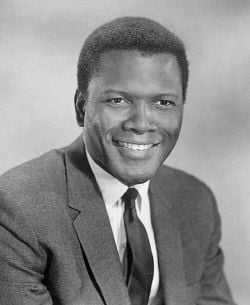
Poitier in 1968
|
|
| Born | February 20 1927 Miami, Florida, U.S. |
|---|---|
| Died | January 6 2022 (aged 94) Beverly Hills, California, U.S. |
| Nationality | American/Bahamian |
| Occupation | Actor, film director, diplomat |
| Years active | 1946–2009 |
| Spouse(s) | Juanita Hardy (m. 1950; div. 1965) Joanna Shimkus (m. 1976) |
| Partner | Diahann Carroll (1959–1968) |
| Children | 6, including Sydney |
Sidney Poitier KBE (/ˈpwɑːtjeɪ/ PWAH-tyay; February 20, 1927 – January 6, 2022) was a Bahamian and American actor, film director, and diplomat. Poitier's family lived in the Bahamas, then still a Crown colony, but he was born unexpectedly in Miami, Florida, while they were visiting, which automatically granted him U.S. citizenship. Later in life, from 1997 to 2007, he was the Bahamian Ambassador to Japan.
In 1964, Poitier won the Academy Award for Best Actor for Lilies of the Field (1963), the first African American actor and first Bahamian to win that honor. He continued with three successful 1967 films which dealt with issues of race and race relations: To Sir, with Love; Guess Who's Coming to Dinner, and In the Heat of the Night.
For his groundbreaking achievements as a Black actor, contributing not just to the world of entertainment but influencing the way society viewed people of color, Poitier received a number of prestigious awards: a knighthood by Queen Elizabeth II; the Golden Globe Cecil B. DeMille Award; the Kennedy Center Honor; an Honorary Academy Award; and the BAFTA Fellowship for outstanding lifetime achievement in film. In 2009, he was awarded the Presidential Medal of Freedom, the highest civilian honor in the United States, by President Barack Obama.
Life
Sidney Poitier was born on February 20, 1927, in Miami, Florida, the youngest of seven children[1] born to Evelyn (née Outten) and Reginald James Poitier, Afro-Bahamian farmers who owned a farm on Cat Island.[2] His father also worked as a cab driver in Nassau.[3] The family would travel to Miami to sell tomatoes and other produce to wholesalers, and Sidney was born unexpectedly while his parents were there on business; his birth was three months premature, and he was not expected to survive. His parents remained in Miami for three months to nurse him to health, when they returned to the Bahamas where Sidney grew up.[2] His birth in the United States entitled him to US citizenship.
Sidney Poitier lived with his family on Cat Island until he was ten, when they moved to Nassau. There he was exposed to the modern world, where he saw his first automobile and first experienced electricity, plumbing, refrigeration, and motion pictures.[4] He was raised Catholic but later became an agnostic, with views closer to deism:
The question of God, the existence or nonexistence, is a perennial question, because we don't know. Is the universe the result of God, or was the universe always there? ... I don't see a God who is concerned with the daily operation of the universe. In fact, the universe may be no more than a grain of sand compared with all the other universes.... It is not a God for one culture, or one religion, or one planet.[5]
At age fifteen, Sidney was sent to Miami to live with his brother's large family, but found it impossible to adjust to the racism in Jim Crow era Florida.[6] At sixteen, he moved to New York City and held a string of jobs as a dishwasher.
In November 1943, during World War II, he lied about his age and enlisted in the Army. He was assigned to a Veteran's Administration hospital in Northport, New York, and was trained to work with psychiatric patients. He became upset with how the hospital treated its patients and feigned mental illness to obtain a discharge. Poitier confessed to a psychiatrist that he was faking his condition, but the doctor was sympathetic and granted his discharge under Section VIII of Army regulation 615–360 in December 1944.[7]
After leaving the Army, he worked as a dishwasher. Seeing an ad for actors he auditioned with the American Negro Theatre. However, his accent and his inability to read the script fluently led to rejection.[8] He bought a radio and practiced speaking by repeating back everything he heard until he got rid of his Bahamian accent. Determined to improve his reading ability, he read the newspaper every night for several weeks with an elderly Jewish waiter, who worked at the restaurant where Poitier washed dishes.[2] Finally, a successful audition landed him a role in an American Negro Theatre production, the same company where he failed his first audition.[4] Thus began his long and illustrious career as an actor.

On April 29, 1950, Poitier married Juanita Hardy, with whom he had four daughters: Beverly, Pamela, Sherri, and Gina. They raised their family in Stuyvesant, New York, in a house on the Hudson River.[9] In 1959, Poitier began a nine-year affair with actress Diahann Carroll.[10] His first marriage ended in divorce in 1965, and on January 23, 1976 he married Joanna Shimkus, a Canadian actress who starred with Poitier in The Lost Man in 1969. They had two more daughters: Anika and Sydney Tamiia. They remained married for the rest of his life. In addition to his six daughters, Poitier had eight grandchildren and three great-grandchildren.[11]
On January 6, 2022, Poitier died at his home in Beverly Hills, California, at the age of 94.[12] According to a copy of his death certificate, the immediate cause of death was cardiopulmonary failure, with Alzheimer's disease and prostate cancer listed as underlying causes.[13]
Career
Early work
Poitier's acting career began when he joined the American Negro Theater. However, he was rejected by audiences as, contrary to what was expected of black actors at the time, Poitier was unable to sing being tone deaf.[14] Determined to refine his acting skills and rid himself of his noticeable Bahamian accent, he spent the next six months dedicating himself to achieving theatrical success. He modeled his legendary speech pattern after radio personality Norman Brokenshire. On his second attempt at the theater, he was noticed and given a leading role in the Broadway production of Lysistrata, through which, though it ran only a failing four days, he received an invitation to understudy for Anna Lucasta.[4]
In 1947, Poitier became a founding member of the Committee for the Negro in the Arts (CNA),[15] an organization whose participants were committed to a left-wing analysis of class and racial exploitation.[16] Among his other CNA-related activities, in the early 1950s he was a Vice Chair of the organization.[17] His participation, along with his friendships with other leftist Black performers, including Canada Lee and Paul Robeson, led to his subsequent blacklisting for a few years.[18] Even associating with Poitier added to the basis for blacklisting Alfred Palca, the writer and producer of one of Poitier's earliest films, the 1954 Go Man Go.[19]
Poitier never signed a loyalty oath, despite being asked in connection with his prospective role in Blackboard Jungle (1955).[20]
1950s
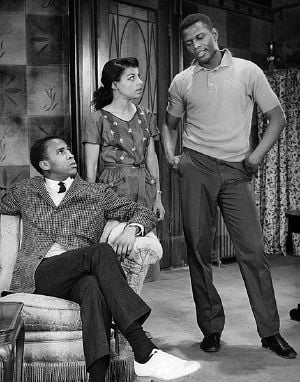
By late 1949, Poitier had to choose between leading roles on stage and an offer to work for Darryl F. Zanuck in the film No Way Out (1950). His performance in No Way Out, as a doctor treating a Caucasian bigot (played by Richard Widmark, who became a friend), was noticed and led to more roles, each considerably more interesting and more prominent than those most African-American actors of the time were offered.[21] In 1951, he traveled to South Africa with the African-American actor Canada Lee to star in the film version of Cry, the Beloved Country.[22] Poitier's distinction continued in his role as Gregory W. Miller, a member of an incorrigible high-school class in Blackboard Jungle (1955). But it was his performance in Martin Ritt's 1957 Edge of the City that the industry could not ignore. It was a pitch towards stardom granted him.
Poitier enjoyed working for director William Wellman on Good-bye, My Lady (1956). Wellman was a big name, he had previously directed the famous Roxie Hart (1942) with Ginger Rogers and Magic Town (1947) with James Stewart. What Poitier remembered indelibly was the wonderful humanity in this talented director. He had a sensitivity that Poitier thought was profound, which Wellman felt he needed to hide.[23] Poitier later praised Wellman for inspiring his thoughtful approach to directing when he found himself taking the helm from Joseph Sargent on Buck and the Preacher in 1971.[24]
In 1958 he starred alongside Tony Curtis in director Stanley Kramer's The Defiant Ones. The film was a critical and commercial success with the performances of both Poitier and Curtis being praised. The film landed eight Academy Award nominations including Best Picture and Best Actor nominations for both stars, making Poitier the first Black male actor to be nominated for a competitive Academy Award as best actor. He also won the British Academy Film Award for Best Foreign Actor for that role.[25]
Poitier acted in the first production of A Raisin in the Sun, directed by Lloyd Richards, alongside Ruby Dee on the Broadway stage at the Ethel Barrymore Theatre in 1959. The play introduced details of Black life to the overwhelmingly White Broadway audiences, while director Richards observed that it was the first play to which large numbers of Black people were drawn. The play was a groundbreaking piece of American theater with Frank Rich, critic from The New York Times writing in 1983, that A Raisin in the Sun "changed American theater forever".[26] For his performance he earned a Tony Award for Best Actor in a Play nomination. That same year Poitier would star in the film adaptation of Porgy and Bess (1959) alongside Dorothy Dandridge. For his performance, Poitier received a 1960 Golden Globe Award nomination for Best Actor in a Motion Picture Musical or Comedy.[27]
1960s
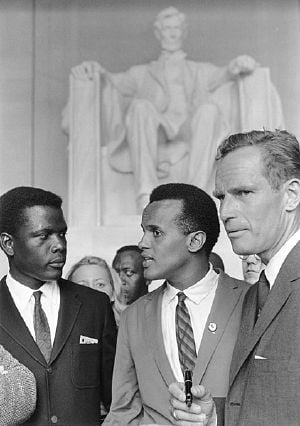
In 1961, Poitier starred in the film adaptation of A Raisin in the Sun for which he received another Golden Globe Award nomination.[28] Also in 1961, Poitier starred in Paris Blues alongside Paul Newman, Joanne Woodward, Louis Armstrong, and Diahann Carroll. The film dealt with the American racism of the time by contrasting it with the open acceptance of Black people in Paris.
In 1963 he starred in Lilies of the Field, playing a handyman helping a group of German-speaking nuns build a chapel. For this role, he won the Academy Award for Best Actor and became the first Black male to win the award.[29] His satisfaction at this honor was undermined by his concerns that this award was more of the industry congratulating itself for having him as a token and it would inhibit him from asking for more substantive considerations afterward. Poitier worked relatively little over the following year; he remained the only major actor of African descent and the roles offered were predominantly typecast as a soft-spoken appeaser.[30]
In 1964, Poitier recorded an album with the composer Fred Katz called Poitier Meets Plato, in which he recited passages from Plato's writings.[2] He also performed in the Cold War drama The Bedford Incident (1965) alongside the film's producer Richard Widmark, the Biblical epic film The Greatest Story Ever Told (1965) alongside Charlton Heston and Max von Sydow, and A Patch of Blue (1965) co-starring Elizabeth Hartman and Shelley Winters.
In 1967, he was the most successful draw at the box office, the commercial peak of his career, with three popular films, To Sir, with Love, and In the Heat of the Night, and Guess Who's Coming to Dinner. Although these three films seemingly shared little similarity, they all, albeit not overtly, dealt with the black and white divide.[23]
In To Sir, with Love, Poitier plays a teacher at a secondary school in the East End of London. The film deals with social and racial issues in the inner city school. The film was met with mixed response; however, Poitier was praised for his performance, with the critic from Time writing, "Even the weak moments are saved by Poitier, who invests his role with a subtle warmth."[31]
In Norman Jewison's mystery drama In the Heat of the Night, Poitier played Virgil Tibbs, a police detective from Philadelphia who investigates a murder in the deep south in Mississippi alongside a cop with racial prejudices played by Rod Steiger. The film was a critical success with Bosley Crowther of The New York Times calling it "the most powerful film I have seen in a long time."[32] Roger Ebert placed it at number ten on his top ten list of 1967 films.[33] Poitier received a Golden Globe Award and British Academy Film Award nomination for his performance.[25] In the Heat of the Night featured his most successful character whose subsequent career was the subject of two sequels: They Call Me Mister Tibbs! (1970) and The Organization (1971).
In Stanley Kramer's social drama Guess Who's Coming to Dinner, Poitier played a man in a relationship with a White woman played by Katharine Houghton. The film revolves around her bringing him to meet with her parents played by Katharine Hepburn and Spencer Tracy. The film was one of the rare films at the time to depict an interracial marriage in a positive light, as interracial marriage historically had been illegal in most states of the United States. It was still illegal in 17 states—mostly Southern states—until June 12, 1967, six months before the film was released. The film was a critical and financial success. In his film review, Roger Ebert described Poitier's character as "a noble, rich, intelligent, handsome, ethical medical expert" and that the film "is a magnificent piece of entertainment. It will make you laugh and may even make you cry."[34] To win his role as Dr. Prentice in the film, Poitier had to audition for Tracy and Hepburn at two separate dinner parties.[23]
Poitier began to be criticized for being typecast as over-idealized African-American characters who were not permitted to have any sexuality or personality faults, such as his character in Guess Who's Coming to Dinner. Poitier was aware of this pattern himself but was conflicted on the matter. He wanted more varied roles; but he also felt obliged to set an example with his characters, by challenging old stereotypes, as he was the only major actor of African descent being cast in leading roles in the American film industry at the time:
If the fabric of the society were different, I would scream to high heaven to play villains and to deal with different images of Negro life that would be more dimensional ... But I’ll be damned if I do that at this stage of the game. Not when there is only one Negro actor working in films with any degree of consistency.[35]
In 1966, he turned down an opportunity to play the lead in an NBC television production of Othello with that spirit in mind.[30] Despite this, many of the films in which Poitier starred would later be cited as social thrillers by both filmmakers and critics.[36] For example, reviewer David Bleiler described No Way Out as "an exceptionally made, tense drama which succeeds both as medical soap opera and social thriller."[37]
1970s
In 1972 Poitier made his feature film directorial debut, the Western Buck and the Preacher, in which he also starred, alongside Harry Belafonte and Ruby Dee. Poitier replaced the original director, Joseph Sargent.[38] The following year he directed his second feature, the romantic drama A Warm December. Poitier also starred in the film alongside Esther Anderson.
During the 1970s Poitier directed several financially successful comedy films. He directed three films starring himself, Bill Cosby, and Harry Belafonte in Uptown Saturday Night (1974). He directed Cosby in Let's Do It Again (1975), and A Piece of the Action (1977). The most successful comedy directed by Poitier ended up being the Richard Pryor-Gene Wilder film Stir Crazy (1980).
Later career
Poitier continued directing, with Fast Forward (1985) and, in 1990, he reunited with Cosby directing him in the family comedy Ghost Dad.
He also continued acting, starring in Shoot to Kill (1988) with Tom Berenger and in Sneakers with Robert Redford and Dan Aykroyd (1992). In 1997, he played a supporting role in The Jackal with Richard Gere and Bruce Willis.
In the 1990s, he starred in several well received television movies and miniseries, such as Separate but Equal (1991), To Sir, with Love II (1996), Mandela and de Klerk (1997), and The Simple Life of Noah Dearborn (1999). He received Emmy nominations for his work in Separate but Equal and Mandela and de Klerk,[39] as well as a Golden Globe nomination for the former.
In 2002, Poitier received the 2001 Honorary Academy Award for his overall contribution to American cinema. Later in the ceremony, Denzel Washington won the award for Best Actor for his performance in Training Day, becoming the second Black actor to win the award. In his victory speech, Washington saluted Poitier by saying "I'll always be chasing you, Sidney. I'll always be following in your footsteps. There's nothing I would rather do, sir."[40]
In a 2008 interview with Tavis Smiley, Poitier explained his responsibility as a black actor and public figure:
I represent a community, and the community asks of me the kind of representation that they’ve never had. So I tried my best to step up to it ... it was my obligation at least to try.[3]
On March 2, 2014, Poitier appeared with Angelina Jolie at the 86th Academy Awards to present the Best Director Award. He was given a standing ovation and Jolie thanked him for all his Hollywood contributions, stating “Since you graced our screens more than 60 years ago, your talent and integrity have shattered barriers and inspired audiences everywhere.”[41] In 2021, the academy dedicated the lobby of the new Academy Museum of Motion Pictures in Los Angeles as the "Sidney Poitier Grand Lobby" in his honor.[42]
Diplomatic service
In April 1997, Poitier was appointed ambassador from the Bahamas to Japan, a position he held until 2007.[43] From 2002 to 2007, he was concurrently the ambassador of the Bahamas to UNESCO.[44]
Legacy
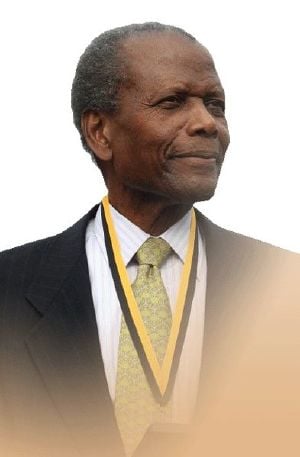
Upon his death, Poitier was described as an "icon" and the "Martin Luther King Jr. of the movies. [45] He was considered by film historians and journalists Hollywood's first African-American film star, instrumental for the diversity of Hollywood and he "paved the way for Black actors in film."[46]
Poitier was the first actor to star in mainstream Hollywood movies that depicted a Black man in a non-stereotypical fashion, and his influence, especially during the 1950s and '60s as role model and image-maker, was immeasurable.[47]
Poitier's influence was not just due to being the first Black actor to be nominated for an Academy Award, the first Black male actor to win the award, and one of the most successful Black directors, he was also a great actor:
But what should not be lost among this great man’s many legacies is the fact that he was first and foremost a phenomenal actor, whose peerless performances almost always rose above the limitations of the roles he had the opportunity to play.[48]
He was also described as the "sole representative" of African-Americans in mainstream cinema during the 1950s and 1960s, especially during the height of the American Civil Rights movement.[46] The New York Times noted that Poitier was "an ambassador to white America and a benign emblem of Black power."[49]
While presenting him with the Honorary Academy Award in 2002, Denzel Washington said of Poitier: "Before Sidney, African American actors had to take supporting roles in major studio films that were easy to cut out in certain parts of the country. But you couldn't cut Sidney Poitier out of a Sidney Poitier picture."[45]
Reflecting on Renee Montagne's interview with Poitier, Frank James concluded:
So that steely determination not to be circumscribed by the arbitrariness of skin color is a very real part of Poitier's makeup. That probably explains why he was able to so convincingly portray characters who almost always defied the perverse racial status quo of the 1950s and 1960s. The characters sharply reflected him.[6]
Upon Poitier's death, many released statements honoring him, including President Joe Biden, who wrote in part: "With unflinching grandeur and poise – his singular warmth, depth, and stature on-screen – Sidney helped open the hearts of millions and changed the way America saw itself." Former president Barack Obama noted that Poitier had "[advanced] the nation's dialogue on race and respect" and "opened doors for a generation of actors," remarking that "Through his groundbreaking roles and singular talent, Sidney Poitier epitomized dignity and grace, revealing the power of movies to bring us closer together." Former President Bill Clinton wrote that Poitier "changed Hollywood, America, and the world forever through his many unforgettable performances, and through the strength, grace, and dignity he radiated both on screen and off. I’ll always be deeply grateful that I had the chance to spend time with him through the years."[50]
Many in the entertainment industry also paid tribute to Poitier, including Martin Scorsese who wrote, "For years, the spotlight was on Sidney Poitier. He had a vocal precision and physical power and grace that at moments seemed almost supernatural." Halle Berry, first Black woman to win an Oscar for best actress, wrote:
History will remember Sidney as a giant of the screen, a legendary actor and director, a performer whose enormous talents were eclipsed only by his kindness. I will recall him as my first mirror, and the true measure of a man — and I will forever see him as the angel in the balcony watching over all of us.[51]
Broadway paid tribute when its theaters dimmed their lights on January 19, 2022, at 7:45 pm ET.[52]
Awards and honors
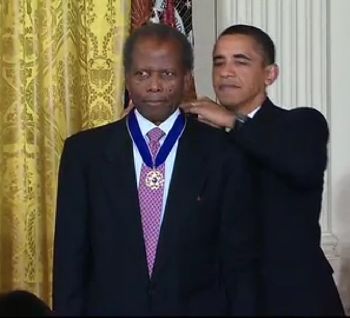
Sidney Poitier received numerous awards during his long career, from the entertainment industry and beyond.
He was the first Black actor to win the Academy Award for Best Actor, for Lilies of the Field (1963).[29] He also received a Grammy Award, two Golden Globe Awards,[28] and a British Academy Film Award.[25]
He received numerous honorary awards during his lifetime:
- In 1982, he received the Golden Globe Cecil B. DeMille Award.[53]
- In 1992, Poitier received the AFI Life Achievement Award.[54]
- In 1994, Poitier was given a star on the Hollywood Walk of Fame.[55]
- In 1999 he received the Screen Actors Guild Life Achievement Award.[56]
- In 2002, he received an honorary Oscar from the Academy “for his extraordinary performances and unique presence on the screen and for representing the motion picture industry with dignity, style and intelligence throughout the world.”[47]
- In 2016 he received the BAFTA Fellowship for outstanding lifetime achievement in film.[57]
He was granted a knighthood by Queen Elizabeth II in 1974.[58]
In 1995, Poitier received the Kennedy Center Honor, an annual honor given to those in the performing arts for their lifetime of contributions to American culture.[59]
In 2009, he was awarded the Presidential Medal of Freedom, the highest civilian honor in the United States, by President Barack Obama.[60]
Notes
- ↑ Sidney Poitier, This Life (Ballantine Books, 1981, ISBN 978-0345294074).
- ↑ 2.0 2.1 2.2 2.3 Aram Goudsouzian, Sidney Poitier: Man, Actor, Icon (The University of North Carolina Press, 2014, ISBN 978-1469622934).
- ↑ 3.0 3.1 Emily Coakley, Sidney Poitier, Pioneering African-American Actor SweetSearch 2Day, May 26, 2017. Retrieved August 24, 2022.
- ↑ 4.0 4.1 4.2 Sidney Poitier, The Measure of a Man: A Spiritual Autobiography (HarperSanFrancisco, 2007, ISBN 978-0061357909).
- ↑ Sidney Poitier, Life Beyond Measure: Letters to my Great-Granddaughter (HarperOne, 2009, ISBN 0061496200), 84-86.
- ↑ 6.0 6.1 Frank James, Sidney Poitier's Reflections Of Dignity NPR, May 20, 2009. Retrieved August 24, 2022.
- ↑ Carol Bergman, Sidney Poitier (All America Distributors Corp, 1990, ISBN 978-0870675669).
- ↑ Sidney Poitier Biography and Interview American Academy of Achievement, February 17, 2009. Retrieved August 24, 2022.
- ↑ Stuyvesant Manor Stuyvesant Outdoor Adventures. Retrieved August 24, 2022.
- ↑ Lois Armstrong, Guess Who's Coming to Terms at Last with His Kids, Racial Politics and Life? Sidney Poitier People, August 4, 1980. Retrieved August 24, 2022.
- ↑ Sir Sidney Poitier Tribute Award: Sir Sidney Poitier to bestow his name to the Bahamas International Film Festival (BIFF) Career Achievement Award Bahamas International Film Festival (BIFF), April 8, 2015. Retrieved August 24, 2022.
- ↑ Jacob Stolworthy, Legendary actor Sidney Poitier, first Black man to win Best Actor Oscar, dies aged 94 The Independent, January 7, 2022. Retrieved August 24, 2022.
- ↑ Sidney Poitier Death Certificate Revealed TMZ, January 18, January 2022. Retrieved August 24, 2022.
- ↑ Sidney Poitier: The actor who broke down Hollywood's racial barriers BBC, January 7, 2022. Retrieved August 24, 2022.
- ↑ Jocelyn Buckner, "Sidney Poitier" in The Cambridge Encyclopedia of Stage Actors and Acting edited by Simon Williams (Cambridge University Press, 2015, ISBN 978-0521769549), 456.
- ↑ Judith E. Smith, Finding a New Home in Harlem: Alice Childress and the Committee for the Negro in the Arts American Studies Faculty Publication Series 14, 2017. Retrieved August 24, 2022.
- ↑ Mary Washington, The Other Black List: The African American Literary and Cultural Left of the 1950s (Columbia University Press, 2015, ISBN 978-0231152716).
- ↑ Aram Goudsouzian, Sidney Poitier: Man, Actor, Icon (The University of North Carolina Press, 2014, ISBN 978-1469622934).
- ↑ Bruce Weber, Four Decades After He Was Blacklisted, A Writer-Producer Finally Gets Credit The New York Times, August 20, 1997. Retrieved August 24, 2022.
- ↑ Jacqueline Trescott, The Prime Time of Sidney Poitier The Washington Post, April 7, 1991. Retrieved August 24, 2022.
- ↑ Emily Kubincanek, 'No Way Out' and the Best of "Social Message" Film Noir Film School Rejects, November 21, 2021. Retrieved August 24, 2022.
- ↑ Nicholas Grant, Crossing the Black Atlantic: The Global Antiapartheid Movement and the Racial Politics of the Cold War Radical History Review, January 1, 2014. Retrieved August 24, 2022.
- ↑ 23.0 23.1 23.2 Philip Powers, Sidney Poitier Black and White: Sidney Poitier's Emergence in the 1960s as a Black Icon (1M1 Digital, 2020).
- ↑ Vincent Canby, Poitier Directs 'Buck and the Preacher' The New York Times, April 29, 1972. Retrieved August 24, 2022.
- ↑ 25.0 25.1 25.2 Sidney Poitier's BAFTA wins and nominations BAFTA. Retrieved August 24, 2022.
- ↑ Frank Rich, Theater: 'Raisin in Sun,' Anniversary in Chicago The New York Times, October 5, 1983. Retrieved August 24, 2022.
- ↑ Porgy and Bess Hollywood Foreign Press Association. Retrieved August 24, 2022.
- ↑ 28.0 28.1 Sidney Poitier Golden Globes. Retrieved August 24, 2022.
- ↑ 29.0 29.1 Dave Kaufman, Sidney Poitier First Black Ever To Receive ‘Best Actor’ Oscar Variety, April 14, 1964. Retrieved August 24, 2022.
- ↑ 30.0 30.1 Mark Harris, Pictures at a Revolution: Five Movies and the Birth of the New Hollywood (Penguin Books, 2009, ISBN 0143115030).
- ↑ Cinema: Class War TIME, June 30, 1967. Retrieved August 24, 2022.
- ↑ Bosley Crowther, Screen: 'In the Heat of the Night,' a Racial Drama; Poitier Plays Northern Detective in South The New York Times, August 3, 1967. Retrieved August 24, 2022.
- ↑ Roger Ebert, The Best 10 Movies of 1967 December 31, 1967. Retrieved August 24, 2022.
- ↑ Roger Ebert, Guess Who's Coming to Dinner January 25, 1968. Retrieved August 24, 2022.
- ↑ Nora McGreevy, How Sidney Poitier Rewrote the Script for Black Actors in Hollywood Smithsonian Magazine, January 7, 2022. Retrieved August 24, 2022.
- ↑ Leonard Maltin, Leonard Maltin's 2009 Movie Guide (Plume, 2008, ISBN 978-0452289789).
- ↑ David Bleiler (ed.), TLA Film and Video Guide 2000–2001: The Discerning Film Lover's Guide (Griffin, 1999, ISBN 978-0312243302).
- ↑ Buck and the Preacher AFI. Retrieved August 24, 2022.
- ↑ Sidney Poitier Television Academy. Retrieved August 24, 2022.
- ↑ Tom O'Neil, Movie Awards: The Ultimate, Unofficial Guide to the Oscars, Golden Globes, Critics, Guild, & Indie Honors (Berkley Publishing Group, 2003, ISBN 978-0399529221).
- ↑ Felix Kessler, Beloved Hollywood actor Sidney Poitier dies at 94 Fortune, January 7, 2022. Retrieved August 24, 2022.
- ↑ Scott Feinberg, Academy Museum Dedicates Grand Lobby to Sidney Poitier The Hollywood Reporter, August 30, 2021. Retrieved August 24, 2022.
- ↑ Legendary Actor Sidney Poitier Dead at 94 NBC San Diego, January 7, 2022. Retrieved August 24, 2022.
- ↑ New play about Sidney Poitier in development for Broadway run Broadway News, December 7, 2021. Retrieved August 24, 2022.
- ↑ 45.0 45.1 Hannah Yasharoff, Trailblazing star Sidney Poitier, first Black man to win best actor Oscar, dies at 94 USA Today, January 7, 2022. Retrieved August 24, 2022.
- ↑ 46.0 46.1 William Grimes, Sidney Poitier, Who Paved the Way for Black Actors in Film, Dies at 94 The New York Times, January 7, 2022. Retrieved August 24, 2022.
- ↑ 47.0 47.1 Duane Byrge and Mike Barnes, Sidney Poitier, Regal Star of the Big Screen, Dies at 94 The Hollywood Reporter, January 7, 2022. Retrieved August 24, 2022.
- ↑ Adam Howard, Sidney Poitier has many legacies, but his acting should not be lost among them The Grio, January 7, 2022. Retrieved August 24, 2022.
- ↑ Adam Howard, Sidney Poitier legacy still looms large in post-#OscarsSoWhite era MSNBC, April 6, 2016. Retrieved August 24, 2022.
- ↑ Ted Johnson, Joe Biden Says Sidney Poitier “Changed The Way America Saw Itself”; Barack Obama Praises “Singular Talent” Deadline, January 7, 2022. Retrieved August 24, 2022.
- ↑ Elise Brisco, 'Legacy to behold': Joe Biden, Denzel Washington, Martin Scorsese honor trailblazer Sidney Poitier USA Today, January 13, 2022. Retrieved August 24, 2022.
- ↑ Andrew Gans, Broadway Dims Its Lights in Memory of Academy Award Winner Sidney Poitier January 19 Playbill, January 19, 2022. Retrieved August 24, 2022.
- ↑ Cecil B. DeMille Award Winners: Every Star Who's Ever Earned the Golden Globes' Big Honor People. Retrieved August 24, 2022.
- ↑ AFI Life Achievement Award | Sidney Poitier The Black Reel Awards, January 18, 2011. Retrieved August 24, 2022.
- ↑ Sidney Poitier Hollywood Walk of Fame. Retrieved August 24, 2022.
- ↑ The 6th annual screen actors guild awards Screen Actors Guild Awards. Retrieved August 24, 2022.
- ↑ Sir Sidney Poitier: BAFTA Fellowship in 2016 BAFTA, January 26, 2016. Retrieved August 24, 2022.
- ↑ Award of Honorary Knight Commander of the British Empire (KBE) to Sidney Poitier, actor... The National Archives, May 16, 2005. Retrieved August 24, 2022.
- ↑ Connie Cass, Kennedy Center Honors Neil Simon, B.B. King, Sidney Poitier AP, September 5, 1995. Retrieved August 24, 2022.
- ↑ Ruth McCann and Anne E. Kornblut, Sidney Poitier, Sen. Ted Kennedy Among 16 Who Receive Medal of Freedom The Washington Post, September 13, 2009. Retrieved August 24, 2022.
References
ISBN links support NWE through referral fees
- Bergman, Carol. Sidney Poitier. All America Distributors Corp, 1990. ISBN 978-0870675669
- Bleiler, David (ed.). TLA Film and Video Guide 2000–2001: The Discerning Film Lover's Guide. Griffin, 1999. ISBN 978-0312243302
- Goudsouzian, Aram. Sidney Poitier: Man, Actor, Icon. The University of North Carolina Press, 2014. ISBN 978-1469622934
- Harris, Mark. Pictures at a Revolution: Five Movies and the Birth of the New Hollywood. Penguin Books, 2009. ISBN 0143115030
- Maltin, Leonard. Leonard Maltin's 2009 Movie Guide. Plume, 2008. ISBN 978-0452289789
- O'Neil, Tom. Movie Awards: The Ultimate, Unofficial Guide to the Oscars, Golden Globes, Critics, Guild, & Indie Honors. Berkley Publishing Group, 2003. ISBN 978-0399529221
- Poitier, Sidney. This Life. Ballantine Books, 1981. ISBN 978-0345294074
- Poitier, Sidney. The Measure of a Man: A Spiritual Autobiography. HarperSanFrancisco, 2007. ISBN 978-0061357909
- Poitier, Sidney. Life Beyond Measure: Letters to My Great-Granddaughter. HarperOne, 2009. ISBN 0061496200
- Powers, Philip. Black and White: Sidney Poitier's Emergence in the 1960s as a Black Icon. 1M1 Digital, 2020. ASIN B08NYX4YSZ
- Washington, Mary. The Other Black List: The African American Literary and Cultural Left of the 1950s. Columbia University Press, 2015. ISBN 978-0231152716
- Williams, Simon (ed.). The Cambridge Encyclopedia of Stage Actors and Acting. Cambridge University Press, 2015. ISBN 978-0521769549
External links
All links retrieved January 27, 2023.
- Poitier breaks new ground with Oscar win BBC News, April 13, 1964.
- Sidney Poitier at the Internet Movie Database
- Sidney Poitier films ranked from worst to best
- Sidney Poitier Academy of Achievement.
- Sidney Poitier The Kennedy Center.
- Sidney Poitier Black Film Archive.
- Sidney Poitier American Masters (PBS).
- Sidney Poitier, An Outsider in Hollywood ARTE France, 2008.
|
|||||||||||||||||
Credits
New World Encyclopedia writers and editors rewrote and completed the Wikipedia article in accordance with New World Encyclopedia standards. This article abides by terms of the Creative Commons CC-by-sa 3.0 License (CC-by-sa), which may be used and disseminated with proper attribution. Credit is due under the terms of this license that can reference both the New World Encyclopedia contributors and the selfless volunteer contributors of the Wikimedia Foundation. To cite this article click here for a list of acceptable citing formats.The history of earlier contributions by wikipedians is accessible to researchers here:
- Sidney_Poitier history
The history of this article since it was imported to New World Encyclopedia:
- History of "Sidney Poitier"
Note: Some restrictions may apply to use of individual images which are separately licensed.
↧ Download as ZWI file | Last modified: 02/03/2023 22:57:56 | 19 views
☰ Source: https://www.newworldencyclopedia.org/entry/Sidney_Poitier | License: CC BY-SA 3.0
 ZWI signed:
ZWI signed: KSF
KSF